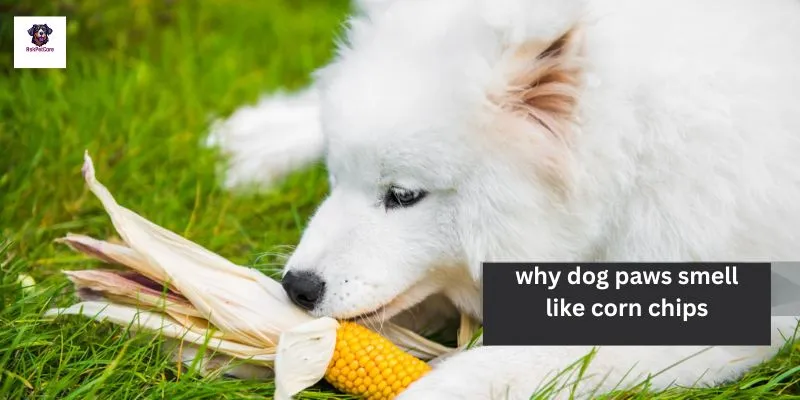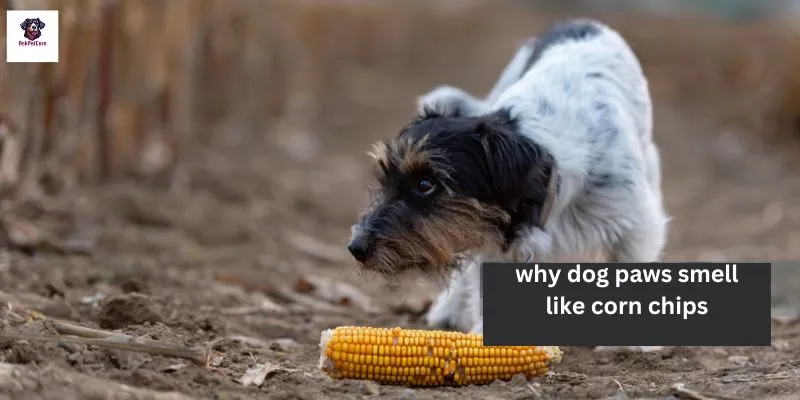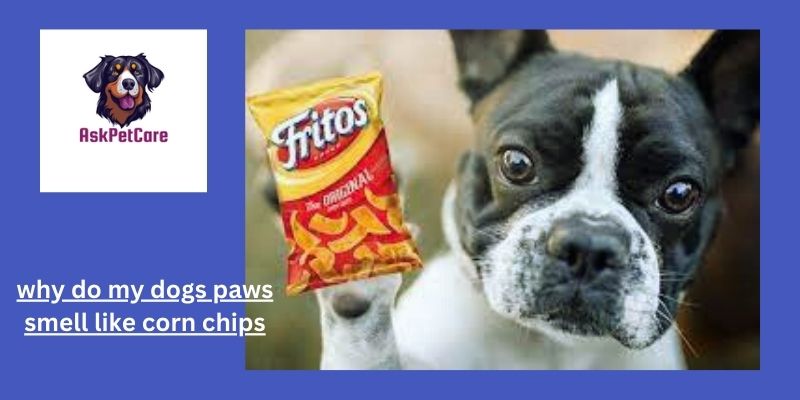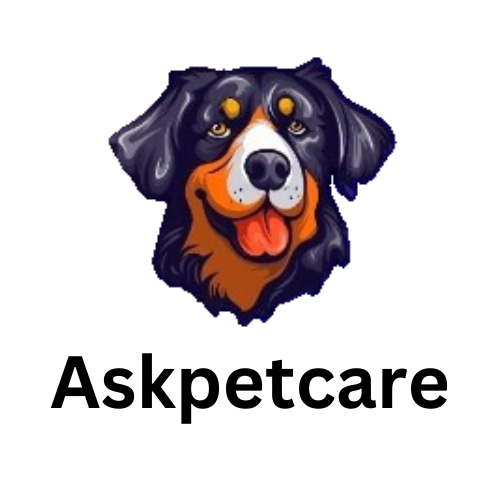Hello, dog lovers! I am Dr. Arif Aziz, and in this blog post, I will explain briefly why do my dog’s paws smell like corn chips. Have you ever noticed a strange scent coming from your canine companion’s paws? You’re not alone. Many dog owners wonder; we’ll research the charming world of Frito Feet and uncover the reasons behind this interesting wonder.
Many dog owners notice this odor and wonder why their furry friend’s paws smell like snacks. Well, the answer is simpler than you might think. Just like humans, dogs have bacteria on their skin, especially on their paw pads. When dogs sweat, this bacteria mixes with the sweat and produces an acid that smells like corn chips. So, if your dog’s paws smell like corn chips, don’t worry – it’s perfectly normal!

While writing this blog, I’m using what I’ve learned from my studies in veterinary medicine and running my pet clinic for 14 years. I’ve also gained knowledge from taking care of pets. The ideas I’m sharing come from knowing about animal health, pet care, and what’s best for our furry friends. Everything I’m saying is based on research, my experience working with animals, and my love for keeping pets healthy and happy.

Now Understand the Phenomenon of why do dog’s paw smells like popcorn:
- Have you ever wondered why your dog’s paws smell like corn chips? It might seem odd, but there’s a simple scientific explanation behind this curious phenomenon.
- The primary reason behind the corn chip odor emanating from your dog’s paws lies in the combination of bacteria and sweat. Just like humans, dogs have sweat glands that help regulate their body temperature. However, unlike humans who have sweat glands distributed all over their bodies, dogs primarily sweat through their paw pads.
- Now, let’s talk about bacteria. Dogs naturally have bacteria living on their skin, including their paw pads. These bacteria are part of the normal flora of the skin and play various roles in maintaining skin health.
- When your dog sweats through their paw pads, especially when they’re warm or active, the moisture creates an environment conducive to bacterial growth. This is particularly true between their toes and on their paw pads where sweat can accumulate.
- As these bacteria break down the sweat, they produce organic acids as byproducts. One of these acids, known as propionic acid, is the main culprit behind the corn chip-like odor. Interestingly, propionic acid is also found in various food items, including corn chips, which is why the smell is reminiscent of everyone’s favorite snack.
- The corn chip odor from your dog’s paws is a result of bacteria breaking down sweat on their paw pads, producing organic acids like propionic acid. While it might seem strange, it’s perfectly normal and usually nothing to worry about. However, it’s always a good idea to keep an eye on your dog’s paw health and consult a veterinarian if you notice any unusual changes or signs of discomfort.

Now, let’s talk about bacteria that cause popcorn-like smell:
Here are five common types of bacteria that are part of the normal flora found on dogs’ skin, including their paw pads:
- Staphylococcus spp. (Staphylococcus aureus, Staphylococcus epidermidis)
- Streptococcus spp. (Streptococcus canis)
- Corynebacterium spp.
- Pseudomonas spp.
- Malassezia spp.
Let’s delve into the role of bacteria, which are part of the normal flora on a dog’s skin, including their paw pads, and how they contribute to maintaining skin health.
- Protection: The presence of beneficial bacteria on the skin acts as a protective barrier against harmful microorganisms. These beneficial bacteria compete with potentially harmful pathogens for space and nutrients, helping to prevent infections and maintain the overall health of the skin.
- Immune System Support: Certain bacteria stimulate the dog’s immune system, helping to strengthen its ability to fight off infections and diseases. This interaction between the immune system and the bacteria on the skin is crucial for maintaining a healthy balance and preventing the overgrowth of harmful microorganisms.
- Skin pH Regulation: Bacteria on the skin, including the paw pads, help regulate the pH balance of the skin. A balanced pH level is essential for maintaining the skin’s integrity and preventing conditions such as dryness, irritation, or excessive oiliness.
- Nutrient Metabolism: Some bacteria on the skin play a role in metabolizing certain nutrients present in sweat and sebum (skin oils). This metabolic activity not only contributes to the overall health of the skin but also helps create an environment that is less conducive to the growth of harmful bacteria.
- Wound Healing: In the event of a minor injury or abrasion on the skin, beneficial bacteria can help facilitate the wound healing process. They may produce substances that promote tissue repair and regeneration, aiding in faster recovery and reducing the risk of secondary infections.
- In summary, the bacteria that naturally inhabit a dog’s skin, including their paw pads, are essential for maintaining skin health. They contribute to protecting the skin against pathogens, supporting the immune system, regulating skin pH, metabolizing nutrients, and aiding in wound healing. Maintaining a balanced and diverse microbial community on the skin is key to ensuring optimal skin health and overall well-being for our canine companions.

Now understand the Factors Contributing to Frito Feet:
- Heat and Humidity: Warm and humid environments can increase sweating in dogs, leading to more moisture on their paw pads and providing an ideal breeding ground for bacteria.
- Excessive Sweating: Some dogs may naturally sweat more than others, especially when they’re active or stressed. Increased sweating can contribute to a buildup of moisture on the paw pads, exacerbating paw odor.
- Poor Air Circulation: Limited airflow around the paw pads, such as in tight-fitting shoes or boots, can trap moisture and create a favorable environment for bacterial growth.
- Lack of Paw Hygiene: Dogs that do not receive regular paw care, including grooming and cleaning, may be more prone to Frito feet due to the accumulation of dirt, debris, and bacteria on their paw pads.
- Skin Fold Formation: Breeds with skin folds, such as Bulldogs or Shar-Peis, may experience increased moisture and bacterial growth in the folds around their paw pads, contributing to paw odor.
- Skin Allergies: Dogs with skin allergies or sensitivities may experience inflammation and irritation on their paw pads, leading to increased sweating and bacterial proliferation.
- Yeast Infections: Overgrowth of yeast, such as Malassezia spp., on the skin, including the paw pads, can contribute to a foul odor resembling Frito feet.
- Poor Diet: Nutrition plays a significant role in skin health. Dogs with imbalanced diets or food sensitivities may experience skin issues, including increased paw odor.
- Genetics: Certain breeds may be genetically predisposed to sweating more or having skin conditions that contribute to paw odor.
- Underlying Health Conditions: Medical conditions such as hormonal imbalances, immune system disorders, or metabolic diseases can affect a dog’s skin health and contribute to paw odor.
- Understanding these factors can help dog owners identify potential triggers for Frito feet and take appropriate steps to manage paw odor and maintain their dog’s overall paw health.
Now understand when paw odor might indicate underlying health issues:
Let’s address the health implications of Frito feet and when paw odor might indicate underlying health issues:
- Concerns about Frito Feet: In most cases, Frito feet, or the corn chip-like odor emanating from a dog’s paws, are not a cause for major concern regarding the dog’s health. This odor is usually due to natural bacterial growth on the skin and is considered a normal phenomenon in many dogs.
- Indications of Underlying Health Issues: While Frito feet themselves may not be alarming, certain changes in paw odor or accompanying symptoms may indicate underlying health issues that require attention. Some of these health issues include:
- Bacterial Infections: Persistent or foul-smelling paw odor accompanied by redness, swelling, or discharge may indicate a bacterial infection of the skin, such as pyoderma.
- Yeast Infections: An overpowering or musty odor resembling moldy bread, along with redness, itchiness, or greasy discharge, could signal a yeast infection, particularly caused by Malassezia spp.
- Allergies: Dogs with allergies, whether to food, environmental factors, or contact allergens, may experience skin inflammation, itching, and paw odor as a result of allergic reactions.
- Skin Fold Intertrigo: Breeds with skin folds, such as Bulldogs or Pugs, are prone to skin fold intertrigo, a condition characterized by inflammation and infection in the skin folds, including those around the paw pads.
- Fungal Infections: Certain fungi, such as dermatophytes (causing ringworm) or other opportunistic fungi, can infect the skin and contribute to paw odor, often accompanied by hair loss, crusting, or scaling.
- Hormonal Imbalances: Endocrine disorders, such as hypothyroidism or Cushing’s disease, can affect a dog’s skin health and lead to changes in paw odor due to alterations in skin oil production and bacterial growth.
- Metabolic Diseases: Metabolic disorders, such as diabetes mellitus, can impact skin health and contribute to conditions like diabetic dermatopathy, characterized by skin changes and increased susceptibility to infections.
- Autoimmune Diseases: Autoimmune conditions, such as pemphigus or lupus, can manifest with skin lesions, ulcers, or crusting on the paw pads, accompanied by paw odor.
- Trauma or Injury: Paw odor following trauma or injury to the paw pads, such as cuts, burns, or foreign body penetration, may indicate infection or tissue damage requiring veterinary attention.
- Parasitic Infestations: Infestations with parasites like fleas, ticks, or mites can cause skin irritation, inflammation, and secondary infections, leading to changes in paw odor.
- Understanding these potential health issues associated with paw odor can help dog owners recognize when Frito feet may indicate an underlying problem and prompt them to seek veterinary evaluation and treatment for their furry companions.

Why do my dog’s paws smell like corn chips? Reasons the Science Behind Frito Feet
The Tenants/occupants:
Two types of bacteria, Pseudomonas and Proteus, like to live in warm and wet places, such as the spaces between your dog’s paw pads.
The Food:
These bacteria eat things like sweat, dead skin cells, and other stuff found on your dog’s paws. It’s like their favorite snack.
The Byproduct:
While they eat, these bacteria make something called putrescine. It’s like their waste, but with a twist.
The Aroma:
This putrescine stuff has a special smell—it’s like the scent of corn chips! So, when you smell Fritos coming from your dog’s paws, you can thank these bacteria and their smelly waste.
So, why exactly do dogs have Frito feet? The spaces between their paw pads create the perfect environment for bacteria to increase.
If you’ve ever wondered whether Frito feet are normal, rest assured—they are. While the scent may be unusual, it’s typically harmless and indicative of the natural bacterial flora present on your dog’s skin.
While Frito feet are generally harmless, excessive odor or other symptoms such as redness, swelling, or discharge may permit a trip to the veterinarian.
The phenomenon of a dog’s paws smelling like corn chips, often referred to as “Frito feet,” is a common occurrence among many dogs. The distinctive scent is usually caused by a combination of factors, primarily related to the presence of natural bacteria and yeast on the dog’s skin and paws.
Natural Microorganisms:
Dogs, like humans, have naturally occurring bacteria and yeast on their skin. These microorganisms are part of the body’s natural flora and play a role in maintaining skin health and function. The specific bacteria and yeast present on a dog’s paws can produce organic compounds that emit a distinct odor, reminiscent of corn chips or popcorn.
Moisture and warmth:
The paws of dogs are exposed to various environmental elements, including moisture, warmth, and contact with different surfaces during walks and outdoor activities. Moisture, especially when trapped between the paw pads, can create an ideal environment for the proliferation of bacteria and yeast. Warm and humid conditions further facilitate the growth of microorganisms, contributing to the development of the characteristic corn chip odor.

Natural grooming behavior:
Dogs instinctively engage in grooming behaviors, such as licking and chewing their paws, to maintain cleanliness and remove foreign particles.
Diet and Nutrition:
Although less common, dietary factors can also influence the odor emitted by a dog’s paws. Certain food ingredients or dietary imbalances may affect the composition of skin oils and secretions, potentially altering the scent of the paws. However, diet-related factors are typically secondary to microbial activity and environmental influences.
It’s important to note that a mild corn chip odor from your dog’s paws is generally considered normal and may not indicate any underlying health concerns. However, if the odor becomes exceptionally strong and persistent or is accompanied by other symptoms such as redness, swelling, or discharge, it may warrant further investigation by a veterinarian.
summary/conclusion.
I think you will clearly understand why do my dog’s paws smell like corn chips.
The corn chip odor emanating from your dog’s paws is primarily attributed to the presence of natural bacteria and yeast, environmental factors, and grooming behavior. Maintaining good paw hygiene, ensuring proper drying after walks or baths, and monitoring for any signs of irritation or infection can help keep your dog’s paws healthy and odor-free. If you have concerns about why do my dog’s paws smell like corn chips or overall paw health, consulting with your veterinarian is recommended for proper evaluation and guidance.
This expanded table provides a more detailed explanation of why do my dog’s paws smell like corn chips.
|
Reason |
Explanation |
| Bacteria between paw pads | Dogs’ paws are cozy spaces for bacteria like Pseudomonas and Proteus to hang out. They flourish in warm, moist environments, and the areas between your dog’s paw pads are perfect places for them to live. |
| Bacteria’s Snack | These bacteria aren’t picky eaters. They eat things like sweat, dead skin cells, and other organic matter found on your dog’s paws. |
| Byproduct | As these bacteria chew away, they create a molecule called putrescine. It’s like their waste product, but with a surprising twist. |
| Corn Chip Scent | Here’s where it gets interesting: putrescine has a unique odor that smells like corn chips! So, the next time you catch a whiff of Fritos coming from your dog’s paws, you can thank these busy bacteria tenants and their funky party byproduct. |
Now understand how to manage Paw Odor:
Here are some practical tips for dog owners to manage their dog’s paw odor and maintain paw hygiene:
-
- Regular Paw Checks: Make it a habit to inspect your dog’s paws regularly for any signs of irritation, redness, swelling, or unusual odors. Early detection of paw issues can help prevent them from worsening.
- Paw Cleaning: Clean your dog’s paws with a damp cloth or pet-safe wipes after outdoor walks or playtime to remove dirt, debris, and potentially harmful bacteria. Pay special attention to the spaces between the toes and the paw pads.
- Foot Soaks: Periodically soak your dog’s paws in a solution of warm water and mild pet-safe shampoo or an antiseptic solution recommended by your veterinarian. This can help cleanse the paw pads and alleviate paw odor.
- Trimming Paw Hair: Keep the hair between your dog’s toes and around the paw pads trimmed to prevent matting and accumulation of dirt and bacteria. This can also improve airflow and reduce moisture retention.
- Moisturizing Paw Balms: Apply a pet-safe moisturizing paw balm or lotion to your dog’s paw pads to keep them hydrated and supple, especially in dry or cold weather conditions. Avoid using products containing harsh chemicals or fragrances.
- Drying Paws Thoroughly: After cleaning or outdoor activities, ensure that your dog’s paws are thoroughly dried to prevent moisture buildup, which can contribute to bacterial growth and paw odor.
- Paw Wipes: Keep pet-safe paw wipes handy for quick and convenient paw cleaning on the go, particularly after walks in muddy or dirty environments.
- Pet-Friendly Flooring: If possible, consider using pet-friendly flooring materials in your home, such as hardwood or tile, which are easier to clean and less likely to trap dirt and bacteria that can contribute to paw odor.
- Proper Nutrition: Provide your dog with a balanced and nutritious diet to support overall skin health and reduce the risk of skin issues that can lead to paw odor. Consult your veterinarian for dietary recommendations tailored to your dog’s specific needs.
- Regular Veterinary Check-ups: Schedule regular veterinary check-ups for your dog to monitor their overall health, including their paw health. Your veterinarian can provide guidance on paw care, detect any underlying issues early, and recommend appropriate treatments.
- By incorporating these tips into your dog care routine, you can effectively manage your dog’s paw odor and promote healthy paw hygiene for your furry companion.
Medically here are ten methods of treatment for managing a dog’s paw odor:
-
- Antibacterial or Antifungal Shampoos: Use medicated shampoos specifically formulated to treat bacterial or fungal infections on your dog’s paws. Follow the instructions provided by your veterinarian for proper application and frequency of use.
- Topical Antiseptics: Apply topical antiseptic solutions or sprays recommended by your veterinarian to clean and disinfect your dog’s paw pads. These solutions can help kill bacteria and reduce paw odor.
- Foot Soaks: Soak your dog’s paws in a solution of warm water and antiseptic or antibacterial agents, such as chlorhexidine or povidone-iodine. This can help cleanse the paw pads and alleviate paw odor.
- Antibiotic or Antifungal Medications: In cases of bacterial or fungal infections, your veterinarian may prescribe oral antibiotics or antifungal medications to treat the underlying cause of paw odor. Follow your veterinarian’s instructions and complete the full course of treatment as prescribed.
- Steroid Therapy: For dogs with inflammatory conditions or allergies contributing to paw odor, your veterinarian may recommend steroid therapy to reduce inflammation and alleviate symptoms. Steroids may be administered orally or topically, depending on the severity of the condition.
- Dietary Changes: Switching to a hypoallergenic or limited-ingredient diet may be beneficial for dogs with food allergies or sensitivities that contribute to paw odor. Consult your veterinarian for guidance on selecting an appropriate diet for your dog’s specific needs.
- Allergy Management: Identify and avoid potential allergens that may be triggering allergic reactions in your dog, such as certain foods, pollen, dust mites, or environmental allergens. Your veterinarian may also recommend allergy testing and immunotherapy for long-term management of allergies.
- Hygiene Practices: Maintain good paw hygiene by regularly cleaning your dog’s paws with pet-safe wipes or mild soap and water. Trim excess hair between the toes and around the paw pads to prevent debris buildup and bacterial growth.
- Environmental Control: Minimize exposure to environmental factors that may exacerbate paw odor, such as damp or dirty surfaces, harsh chemicals, or irritants. Provide clean bedding and ensure your dog’s living environment is dry and well-ventilated.
- Consultation with a Veterinary Dermatologist: If paw odor persists despite home remedies and standard treatments, consider seeking a consultation with a veterinary dermatologist. These specialists have advanced training in diagnosing and treating skin conditions in animals and can provide specialized care for your dog’s paw health.
- Always consult your veterinarian for proper diagnosis and treatment recommendations tailored to your dog’s individual needs. Avoid self-diagnosis and over-the-counter treatments without professional guidance, as they may exacerbate underlying issues or cause adverse reactions in your dog.
Antibacterial or Antifungal Shampoos for dog Frito feet cure:
Here are the names of five antibacterial or antifungal shampoos commonly used for treating paw odor and related skin issues in dogs:
-
- Malaseb Medicated Shampoo
- KetoHex Antifungal and Antiseptic Shampoo
- Douxo Chlorhexidine PS Shampoo
- Veterinary Formula Clinical Care Antiseptic and Antifungal Shampoo
- SynergyLabs Veterinary Formula Clinical Care Antiseptic Antifungal Medicated Shampoo
Antibiotic or Antifungal Medications for dog Frito feet cure:
Here are the names of five common antibiotic or antifungal medications prescribed by veterinarians for treating paw odor and related skin issues in dogs:
-
- Clavamox (amoxicillin/clavulanic acid): A broad-spectrum antibiotic often used to treat bacterial infections in dogs, including those affecting the paws.
- Cephalexin (Keflex): Another broad-spectrum antibiotic effective against a wide range of bacterial infections commonly found in dogs, including skin infections.
- Fluconazole (Diflucan): An antifungal medication used to treat yeast infections in dogs, including those affecting the paws and skin folds.
- Ketoconazole (Nizoral): An antifungal medication effective against various fungal infections, including yeast infections commonly found on the skin and paws of dogs.
- Terbinafine (Lamisil): An antifungal medication used to treat fungal infections, including dermatophyte infections (e.g., ringworm) that may affect the paws and skin of dogs.
- These medications are typically prescribed by a veterinarian based on the specific diagnosis and severity of the condition affecting the dog’s paws.
- It’s important to follow your veterinarian’s instructions carefully and complete the full course of treatment to ensure effective resolution of the underlying infection.
.

Veterinary Examination:
If the odor persists despite home remedies, it’s essential to consult with your veterinarian. Your vet can perform a thorough examination to rule out any underlying health concerns and recommend appropriate treatment options.
Is it normal for a dog’s paws to smell like popcorn?
While some dog owners may describe their dog’s paw odor as similar to popcorn or corn chips, it’s essential to recognize that every dog’s scent may vary slightly. The mild, occasional odor from a dog’s paws is generally normal and can be attributed to the natural bacteria and yeast present on the skin. However, if the odor becomes unusually strong, persistent, or accompanied by other symptoms such as redness, swelling, or discharge, it may indicate an underlying issue such as infection or allergies. In such cases, consulting with your veterinarian is recommended to determine the cause and appropriate treatment.
If you like to understand what is corn in dog paws, click it.
Why does my dog itch and smell like corn chips?
If a corn chip-like odor accompanies your dog’s itchiness, it could be due to yeast or bacterial overgrowth on the skin. Yeast and bacteria naturally reside on a dog’s skin, but imbalances can occur due to factors such as allergies, humidity, or compromised immune function. Excessive scratching or licking can exacerbate the issue by creating an environment conducive to bacterial and yeast growth. To address the odor and itchiness:
Follow your veterinarian’s recommendations for ongoing maintenance and prevention of skin issues to keep your dog comfortable and odor-free.

Why do my dog’s paws smell like corn chips all:
The corn chip odor emanating from your dog’s paws is primarily attributed to the presence of natural bacteria and yeast, environmental factors, and grooming behavior. Bacteria and yeast naturally inhabit your dog’s skin and paws, and under certain conditions, such as warmth and moisture, they can proliferate, leading to the characteristic odor.
Why do my dog’s paws smell like corn chips after:
After activities such as walks or exposure to moisture, your dog’s paws may develop a stronger corn chip odor due to the accumulation of dirt, bacteria, and yeast. Moisture from wet grass, puddles, or rain can create a favorable environment for bacterial and yeast growth, intensifying the odor.
Is it bad that my dogs’ feet smell like Fritos:
While a mild corn chip odor from your dog’s paws is generally considered normal, exceptionally strong or persistent odor may indicate an underlying issue such as bacterial or yeast overgrowth, allergies, or skin infections. It’s essential to monitor your dog’s paw health and consult with your veterinarian if you have concerns about the odor.
My whole dog smells like Fritos:
If your entire dog emits a corn chip odor, it may be indicative of bacterial or yeast overgrowth on the skin or other health issues. Proper grooming, regular bathing, and veterinary evaluation can help address the underlying causes of the odor and ensure your dog’s overall health and well-being.
Home remedies for dog Frito feet:
Some home remedies to address Frito feet in dogs include:
Regular paw cleaning with mild pet-friendly shampoo and warm water.
Thorough drying of your dog’s paws after baths or walks.
Use of pet-safe paw wipes for quick cleaning.
Dietary considerations to ensure your dog’s nutrition supports skin and coat health.
Consult with your veterinarian for further evaluation and treatment options if the odor persists despite home remedies.
Here are some stories and insights from dog owners who have dealt with Frito feet:
- Sarah’s Story: Sarah, a dog owner, noticed a distinct corn chip-like odor coming from her Golden Retriever’s paws during the summer months. At first, she was puzzled and worried about her dog’s health. However, after consulting with her veterinarian, she learned that it was a common occurrence known as Frito feet. To manage the odor, Sarah started cleaning her dog’s paws more frequently and using paw wipes with natural ingredients. She also made sure to keep her dog’s paw pads dry after walks and outdoor playtime. With these simple steps, Sarah was able to effectively control her dog’s paw odor and prevent any discomfort.
- Mark’s Experience: Mark, a Labrador owner, noticed that his dog’s paws started smelling like corn chips after a particularly hot and humid summer. Concerned about his dog’s health, Mark consulted with his veterinarian, who recommended using a medicated shampoo containing chlorhexidine for regular paw cleaning. Additionally, Mark made sure to trim the excess hair between his dog’s toes and keep the paw pads dry. Within a few weeks, the paw odor improved significantly, and Mark’s Labrador was back to enjoying outdoor adventures without any discomfort.
- Emily’s Approach: Emily, a rescue dog owner, adopted a mixed breed with sensitive skin issues. Despite regular grooming and paw care, her dog’s paw odor persisted. Determined to find a solution, Emily consulted with a veterinary dermatologist who recommended dietary changes and allergy testing. After identifying and eliminating certain food allergens from her dog’s diet, Emily noticed a remarkable improvement in her dog’s paw odor and overall skin health. Through a combination of specialized diet and proper paw hygiene, Emily successfully managed her dog’s Frito feet and improved her quality of life.
- Jason’s Strategy: Jason, a German Shepherd owner, struggled with managing his dog’s paw odor, which seemed to worsen during the rainy season. Despite regular paw cleaning and grooming, the smell persisted. After consulting with fellow dog owners online, Jason discovered the benefits of using paw balms with natural ingredients like shea butter and coconut oil. He applied the paw balm to his dog’s paw pads regularly to keep them moisturized and protected from environmental irritants. This simple addition to his dog care routine made a noticeable difference in managing paw odor and enhancing his German shepherd’s paw health.
- These personal experiences highlight the diversity of approaches and strategies that dog owners employ to manage Frito feet and maintain their dog’s paw hygiene. By sharing their stories and insights, they offer valuable guidance to others facing similar challenges with their canine companions.
Now explore Products for Paw smell like popcorn:
- Paw Wipes: Pet-safe paw wipes, such as Earthbath All Natural Grooming Wipes or Pogi’s Grooming Wipes, are convenient for quick paw cleaning and odor control.
- Paw Balms: Moisturizing paw balms, like Musher’s Secret Paw Protection Wax or Bodhi Dog Paw Balm, can help soothe and hydrate dry paw pads while reducing paw odor.
- Antiseptic Sprays: Antiseptic sprays containing ingredients like chlorhexidine or tea tree oil, such as Vetericyn Plus Antimicrobial Hydrogel or Bodhi Dog Antifungal and Antibacterial Spray, can help disinfect and deodorize paw pads.
Disclaimer: This information is general advice only. Before starting any treatment or supplement with your pet, please consult your vet first for the best approach to getting your pet back to its best health.
Check with your veterinarian before giving any medication or supplement at home, to be sure it’s safe for your pup. Some substances can be toxic or harmful, including “dog-safe” medications and supplements if they are given at the wrong dosage.
Here are some reference books that are considered authoritative on the topic of dog care, including nail care:
- “The Complete Dog Owner’s Manual” by Dr. Bruce Fogle
- “The Ultimate Guide to Dog Care: Everything You Need to Know to Keep Your Dog Happy and Healthy” by Amy Marder and Andrew Luescher
- “The Veterinarians’ Guide to Natural Remedies for Dogs: Safe and Effective Alternative Treatments and Healing Techniques from the Nations Top by Martin Zucker.
